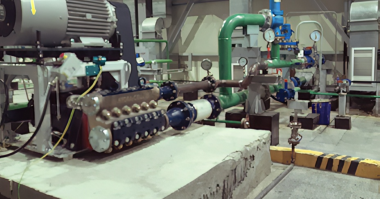Author: Adam Singfield
Proper management (and thus more specifically, construction management) is incredibly important in all kinds of industries. However, the practices and tech implementations in management have a particularly crucial role when it comes to the oil and gas industry.
In the past couple of years, the oil and gas market has experienced steady growth. With the crude oil prices set to recover, logically — companies in these industries are looking towards growth-oriented projects more and more. However, things are not as simple as they superficially seem.
This is mostly due to the fact that the success of these projects does not solely depend on current resource prices. Such oil and gas projects are long-term investments — and their outlook also depends on projects tied to renewable energy. It’s also worth noting that some reports suggest that productivity increases in the construction sector of oil and gas are lagging behind retail and manufacturing construction.
Luckily, when it comes to capital construction productivity — there are ways in which oil and gas companies can raise their productivity. This directly ties into project management practices, agile company cultures, and making use of the advanced analytics which modern digitization gives us. All of these are capable of providing major improvements in the sector.
However, plain old copying of these practices from other industries isn’t likely to yield sufficient returns. There are some aspects in which oil and gas projects are very specific. Not only are lead times longer than in most other industries — but each capital construction project is pretty unique, and can’t rely fully on preceding projects.
Improving Deliverability of Projects
There is an incredible variety when it comes to management technologies and practices which can aid the performance of capital projects in the oil and gas industries. There are four specific practices that may show the most results:
- Agile corporate environments
- Contemporary digital analytics
- Automation
- Project Production Management
Each of these can be used to improve a specific development phase of construction projects; though they could also be applied to other project phases too.
Project Production Management
As of now, the approach of the oil and gas sectors to project management is pretty focused on detailed planning. However, adopting newer PPM practices would provide significant benefits to companies in these industries.
This is because a PPM approach sees each project as a series of separate production systems. Every one of these has its own management processes and practices. If every one of these discrete systems has separate management, making optimizations where they are needed is far easier. Also, it’s easier to review the performance of each system and see where such improvements are needed in the first place.
What PPM essentially does is allow project managers to have more control over all of the parts of the production process for their respective systems. In turn, this lets them mitigate issues and unforeseen challenges more easily; they have control over inventory, different capacities, and ultimately response times for their smaller sections of the larger systems.
In the process of actual on-site construction, companies in the oil and gas sectors have to refocus on achieving a better flow efficiency. This allows them to lessen the overall workload while achieving the maximum possible throughput.
Digitization and Analytics
Digital technologies have the power and potential to transform processes in absolutely every industry. Even though oil and gas are not primarily consumer-oriented — they are not exceptions in this regard. Combined with newly automated processes in engineering, digital information modeling can actually eliminate manual input in a variety of repetitive tasks. Thus, the effort required on the part of management would be significantly lowered; particularly when it comes to functions related to quality control.
The myriad processes tied to procurement can also receive huge benefits from the proper technology application. The digitization and automation of purchases and orders will hugely improve and streamline supply communication. This has the potential to simultaneously make supply chains more transparent while also accelerating the speed at which they operate. Outside of oil and gas industries, e-auction and cost modeling are technologies that are already in wide use; they could mature in this sector as well with the proper implementation.
Digital technologies are also capable of increasing the productivity levels in construction in these sectors as well. These days, construction sites in other industries utilize “digital twins”; technologies that create digital replicas that update the view of physical assets in real-time. Such technology is incredibly precise, due to the fact that the models are created using laser scans of each individual construction site.
To be more precise — the biggest advantage that this technology provides is the ability to perform real-time inspections and progress checks without ever leaving the office. An incredible level of detail in progress tracking can be achieved using Bluetooth tagging and radio identification of specific parts.
This allows managers to track even the smallest mechanical part from the manufacturer’s production line right down to the construction site where it will be implemented; greatly improving the predictability of timetables and schedules. These technologies, along with advanced work packaging, are set to become standards in civil construction in the next couple of years.
The process of digitizing documentation is also quite important for streamlining the processes tied to construction management; we’re talking about myriad drawings, receipts, handovers, and various permits. This is currently not the standard in oil and gas construction sites and companies; huge amounts of paper are still used, both harming the environment and slowing down every management process at the same time.
As we have already mentioned above, data analytics are set to become more important than ever for oil and gas industries. If you utilize project data in the right way, key performance indicators can be surmised and analyzed with greater precision; especially when it comes to the production of useful inspection reports that are crucial for raising project quality. The tagging technologies that we’ve mentioned above will definitely play a key role here, particularly when it comes to performance monitoring of all kinds.
However, these days oil and gas construction project teams don’t really utilize the aforementioned data to its fullest potential. This is because much of the information is not even digitized; existing in huge swathes of paper or in cluttered electronic spreadsheets. With a lack of easily accessible central information repositories, true data analytics are made far more difficult.
A certain level of standardization in the systems, styles, and formats of oil and gas projects will have to be achieved. This will prevent data from one project from being unusable in subsequent projects.
Agile Environments
While the oil and gas industries are still largely foreign to the use of agile management, such practices have been around various industries for the previous two decades. More specifically, they’ve arisen from the practices used in software development industries; but they’re definitely applicable to huge oil and gas corporations as well.
Agile management refers to the division of employees into small, cross-functional sections that constantly communicate and learn from each other. These teams operate in short decision cycles and activity bursts, allowing managers to reach crucial decisions quickly than with other management practices.





Comments